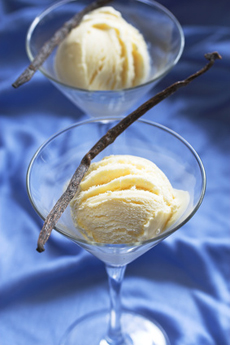August 11, 2011 at 7:56 am
· Filed under Ice Cream-Sorbet-Yogurt, Recipes, Tip Of The Day

Drizzle ice cream with Scotch and serve.
Photo by Elke Dennis | Fotolia. |
|
Years ago, a friend who was a great cook prepared an elaborate dinner for us: intricate courses of beef, fish, and fowl with layers of flavor.
We anticipated something equally elaborate for dessert. So we raised an eyebrow when he scooped vanilla Häagen-Dazs into dishes and topped each scoop with something that seemed bizarre at the time: a jigger of Scotch.
“Really?” we said.
“It’s delicious,” he replied. “Taste it.”
We did, and promptly discovered the easiest fancy dessert in the world. We often serve it at the end of a big dinner. The “recipe” works equally well with Bourbon.
We also created our own spin: sorbet with a jigger of gin (use a very aromatic style such as London Dry or International).
Decades after that first ice cream/Scotch experience, we’ve been presented with a reversed version of that simple pleasure: The Macallan Ice Cream Brownie Sundae.
It’s impressive, but we’ll stick with the two-minute original.
|
THE DIFFERENT STYLES (TYPES) OF GIN
Genever. Genever is the original gin, a rich distillation that’s more like a flavored whiskey than the more familiar English Dry gin. Bols Genever is an example.
London Dry Gin. The British evolved genever into a lighter-bodied, aromatic style that lends itself to mixing. Beefeater, Bombay Sapphire, and Gordon’s are examples.
Navy Strength. While most gins have an A.B.V.* around 40% (80 proof), Navy strength is at least 57% A.B.V. (114 proof).
New Western Gin. This term debuted in the early 21st century to describe small-batch, craft gins which were differentiated from the classic London Dry gin. These gins have flavorings or infusions added in redistillation, and may not be as juniper-forward as London Dry. The infusions can include anything from honey to yuzu.
Plymouth Gin. Made only in Plymouth, England since 1793, it is full-bodied with a balanced blend of botanicals and a long, dry finish. It calls itself “the world’s smoothest gin.” There currently is only one brand, Plymouth.
Old Tom Gin. Sweeter, rounder, and with more botanical expression than London Dry Gin, this style was popular in the 18th century. After many years out of production, it has been relaunched in recent years by Hayman’s. Booth’s and The Dorchester are two more brands of this style.
International Style Gin. Created in recent years by artisan distillers, these gins burst with a complex mixture of botanicals. We love to sip them straight—and pour them on sorbet. Martin Miller’s Gin of London and Bluecoat Gin of Philadelphia (which calls itself “American Dry Gin”) are examples (and our two favorite gins).
Sloe Gin. Sloe gin is a red liqueur made from sloe (blackthorn) berries. It is not a true gin, which is made from juniper berries.
Damson Gin. Not a gin, but a liqueur made from Damson plums.
CHECK OUT WHAT’S HAPPENING ON OUR HOME PAGE, THENIBBLE.COM.
|
Please follow and like us:
Permalink
Comments are closed.



